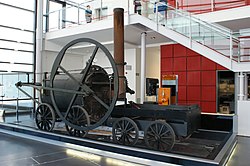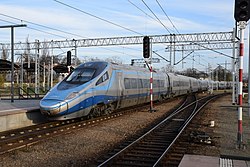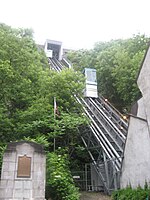Halsuntrian Railways Service
| Halsuntria | |
|---|---|
| Operation | |
| Major operators | Halsunt Rails, Trans-Halsuntria, GRO, Valley Rail Operation |
| Statistics | |
| Passenger km | 26349 km |
| Freight | 24987 km |
| Electrification | |
| Main | Yes |
| Features | |
| No. tunnels | 1046 |
| Longest tunnel | Fedder Tunnel, 17623m |
| No. bridges | 3681 |
| Longest bridge | Krolammer Memorial Bridge, 7139m |
| No. stations | 5110 |
| Highest elevation | Mount Kildin Station, 3907m |
| Lowest elevation | Marks' Center Station, -8m |
The Halsuntrian Railway Service (HRS) is the general term for all railways in Halsuntria, regardless of size. The HRS is the most used mode of interstate transportation in Halsuntria with about 20,000 more passengers than highways each year. The HRS has about 45,000 miles of rail in Halsuntria which can be divided into standard (1372 mm), small (762 mm), and wide (1668 mm) gauges. The standard gauge is the most used in Halsuntria as it makes up most of the rails that goes in and out of the major cities, the next is small which is the large majority of regional routes and overall smaller lines mostly throughout the countryside, it is noted that about 1/2 of these are heritage railways with the sole purpose for tourism. The least used is wide gauge which has a variety of uses and it is mainly for odd jobs such as at a harbor or other industrial facility.
Steam and electric trains are used almost equally when it comes to passenger transport while freight trains are almost exclusively diesel. Despite steam trains being generally slower than electric, they are loved by tourists as well as Halsuntrian citizens as it is unique and has almost became a part of Halsuntrian culture to have steam trains. Trains in general have became a huge part of Halsuntria's history with them being the main mode of transportation and that is due to them having a rich history in Halsuntria dating all the way back to the 1690's. Through that time, Halsuntria has been world-renowned for their rails and take great pride in them with their balance between the steam of yesterday and the electric of tomorrow.
History
The story of trains in Halsuntria date all the way back in the 1710's with the bringing over of the steam engine and goes all the way to today where they have become the most beloved mode of transport in all Halsuntria.
Pre 1820's
In 1711, a Halsuntrian by the name of Lautpils Meroick brought over a steam engine from Thuadia and learned how to use it and fascinated about the idea of using it for transport. He died when one of his engines caught fire and blew up his workshop but he had made sizable progress when his son, Daugen Meroick, took over after his death. When Daugen died in 1779 he had garnerd attention from the public and government to continue the work to make a steam transport. In 1796, a steam car was invented by putting a steam engine on four wheels, it was incapable of carry people and only went 5 miles a hour but was a step in the right direction. Already being used, rails from horse-drawn railways would become the next step for steam engine to go, and they would arrive in a little less than a decade.
In 1804, the train was invented. In Perced, the same town the Meroick's lived, the Meroick was put on the rails using coal as power, it worked at a local iron mill. Over the next 15 years, the train would not get much faster but it would become more widely used as passenger transport and as amusement for the Halsuntrians.
1820-1900
In the 1820's is when trains were greatly expanded to be faster and by the 1830's reached speeds of 30 miles an hour. It was in the 1830's that trains were expected to be used for commercial use transporting people from city to city, town to town, and trains greatly succeeded in doing so. They were able to get people places faster than ever before and engineers by the names of Linus Hyler, Thomas Haschak & Babrig Vatsy would pave the way for the innovation of the train and rail. Those three would not only make trains faster, sleeker and more efficient; they would make rails, bridges, signals, everything that would make trains run more efficient and are a prime reason for trains being as wide used as they are today.
By the 1850's, railroads were being built across Halsuntria through all types of terrain and allowed for traveling between cities seamless and more efficient than any other country in Anteria. New trains were being built seemingly every day and the Train Excitement was in full swing with mass interest in trains throughout Halsuntria. This lasted until the 1900's although it was slowly dying out since the 1870's. The Aeneas became one of the more famous trains for this period as it traveled from Saluntberg to the then largest cities of Endext and Nanisudnit on opposite sides of the country. City rails were being created as well with Saluntberg being a hotspot for new city train innovations with the metro, although there were many problems including the fact it got clouded in steam, it was efficient and was one of the first of its kind. Inclines and other mountain rail were also being created, most notably in the Xylbdun Mountains and Fedder Mountains. It was also during this time that different gauges were being created which later resulted in the three primary gauges that are being used today.
20th Century
The 20th Century started off just as the 19th ended, continuing innovation; making trains faster and more efficient. Major changes however came in the 1920's with the creation of the diesel engine. This was seen as a good and bad thing; on the good side, they were more efficient and were destined to be faster; on the bad side, it would put many fireman out of work due to them not being needed any more. However, diesel trains came ahead and were the primary type of train by the 1950's. Also noted in the Early 20th Century was some innovation relating to light rail by means of trams and trolleys, however it wouldn't take off until the Early 2000's. However, Electric Trains as well came out of this period in the 1940's and were expected to be the primary train type, ahead of the diesel which had the same claim just a decade earlier. They would be popular side by side until steam trains would make a revival in the 1970's in a heritage project to put them back in action. This would cause a large divide in freight and passenger trains which had the same engines doing both, but now diesels worked almost exclusively on freight trains and steam and electric worked exclusively on passenger trains. This divide has lasted till today and has been working efficiently for the Halsuntrian railway industry.
21st Century
The start of the 21st Century was as well the start of the Light Rail Revolution in which major cities around Halsuntria started to implement Light Rail systems in their cities. It's gotten so large to the point where they have more passengers than most metros. Another occurrence was the continual advancement of electric trains, the current primary passenger train. The current most used electric train, the ROH Class 96CFYJ, can reach speeds of up to 150 miles per hour and are on standard rails, along with most electric trains. In terms of steam trains, they make up almost all of the small gauge and still have a sizable appearance on standard gauges and still run routes to cities, and efficiently too. Top speeds on some of them can reach 125 miles per hour and are comparable to electric. Steam trains are still primarily used on heritage railways in the modern age and have limited experience on express ways except for the Vatsy, the one previously mentioned that can go 125 miles per hour.
Gauges
Standard Gauge
Small Gauge
Wide Gauge
Other Trains and Paraphernalia
Although standard trains are the most prevalent in Halsuntria, there are still more types of locomotives/rolling stock in Halsuntria that have become prevalent during the years.
Inclines
Inclines in Halsuntria have been prevalent in many places but primarily in the Fedder and Xylbdun Mountains in cities and mines. Many small ones exist in cities around the country but overall aren't very notable. An exception to this is Saluntberg which has became famous for their inclines going up to the Vanders Plateau from Downtown. They were opened in the 1870's to make the process easier of getting from Vanders to downtown, since then; a total of 19 were built, but only 5 remain in use. In other cities, Nanisudnit is also known for their inclines which go directly from the sea to the Bravek Hills, similar to Saluntberg. The cities of Bafse and Sutle also have inclined railways however are shutting down rapidly due to road construction making the process much easier to get up mountains. However, still a large majority of inclines are to and from mines and having been such for over 160 years, slightly less advanced than the ones in the cities. They typically fit 8 people per car and go around 10 mph.
Metro/Light Rail
Metros and Light Rails have been in Halsuntrian cities since the 1870's and continue to be used in cities in modern day. The first metro used in Halsuntria was in the capital of Saluntberg using steam trains in underground tunnels in 1873. This came after trains that were above ground but were fairly inconvenient making large noise and getting streets dirty. Just 4 year after that, the then 2nd largest city, Endext, implemented trams into its streets that would soon become popular throughout Halsuntria. Then the cities of Marst and Telex put in metros as well and they also became electric making them very efficient by the 1890's. Over the next 80 years, not much would happen apart from the trains and trams developing with the times and them expanding to more cities. By 1980, 6 cities had metros and 14 with trams; by 2000, 7 had metros with 24 getting trams, now considered light rail. Major expanses in light rail occurred in the 2000's fueled by expanses elsewhere in Anteria. This was caused by the increasing outdatedness of metros and how much cheaper they were to build compared to metros. Soon, light rail became the most used mode of city transport. Most models consist of two cars back-to-back that each hold typically 30 people. Most are just a couple of lines reaching from downtown out to the suburbs while some just stay in downtown and some just stay in suburbs.
Signals
Old signals in 1840's Halsuntria used Revolving Disk Signal which depending on which way it was turned, indicated as to whether a train was to stop, go, or continue cautiously. Over the next 120 years, signals would continue to advance with the times including the Double Disk and Semaphore Signal. However, since 1960's the primary signal has been the Color Light Signal. It operates of a red-yellow-green system where green means go, red means stop and yellow means caution.
National Rail Museum
The National Rail Museum is located in Perced, Fedder Department, the same town where the Meroicks lived. It was created in 1954 to commemorate the 150 year anniversary of the train being invented. The museum features trains and train memorabilia from the past 300 years and is the third largest museum in Halsuntria behind the Saluntberg Natural History Center, and the Halsunt Culture Museum. The museum features 51 trains and over 400 pieces of train memorabilia. It has nearly 600 thousand visitors per year and is one of the top attractions in the town.







